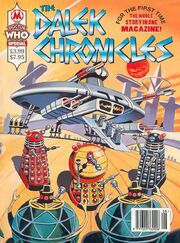- You may wish to consult
The Daleksfor other, similarly-named pages.
The Daleks was the title of a multi-media Daleks-focused Doctor Who spin-off launched by Terry Nation independently from the BBC in 1965 following the success of the first Dalek annuals.
The series principally comprised a series of comics detailing the history of the Daleks from their creation to their discovery of Earth. These were originally published in TV Century 21 magazine between 1965 and 1967, then later reprinted as The Dalek Tapes and collected as The Dalek Chronicles. TV Century 21 also released a tie-in audio production adapting an episode of The Chase.
Nation also hoped to launch The Daleks as a television series. Although these plans fell through, the script for the pilot, which featured Sara Kingdom and Mark Seven battling the Daleks, was eventually released, still under the umbrella of The Daleks, by Big Finish Productions in 2010.
Storyline
The TV Century 21 comics portrayed a unique narrative of the creation of the Daleks. The original humanoid Daleks were diminutive blue men with large heads. For their war against the Thals, these humanoid Daleks had created not just war machines but also neutron bombs that were accidentally detonated by a meteorite fall. The subsequent explosion created mutant Daleks who used the war machines as their shells. This account conflicted with the story recounted in The Daleks and was later contradicted by Genesis of the Daleks.
Later stories told of the expansion of the Dalek Empire and a lengthy war against the Mechanoids and other enemies (tying into The Chase). In most of these, the Emperor Dalek served as the protagonist.
The final comic story of the original run, The Road to Conflict, concerned the Daleks' first encounters with humans and their discovery of the planet Earth. This was intended to lead into Daleks' Invasion Earth 2150 A.D..[1] However, this was altered in the followup story Return of the Elders, written and released thirty years later in Doctor Who Magazine issues 249-254, so as to resolve the timeline contradiction between the 2060s timeframe of the comics, and the 2150s setting usually agreed upon for the Dalek invasion of Earth. Another DWM followup, Deadline to Doomsday, was planned but ultimately unproduced by DWM, though a completed version was later published in the fanzine Vworp Vworp!.
Although the comic used a Dalek origin story which it is hard to reconcile with the later televised version, many characters and elements of the strips later made their way into the TV series, not to mention other DWU media; these include Daleks flying, the character of the Dalek Emperor, a singular, supreme Black Dalek who led the Dalek Empire directly below the Emperor, and even premises such as Daleks who experienced a conflict of faith and began admiring human values (as embodied by Dalek Sec in Daleks in Manhattan/Evolution of the Daleks).
In addition, the series served as an explicit aesthetic influence on another solo Dalek spin-off, the animated webseries Daleks!.
Stories
Comics
Originally, no individual titles were given to the stories. However, some titles were given in the preceding issue's "coming next time" closing caption. After doing research and interviewing those involved in the original strips, John Ainsworth proposed the following titles, which were later used by Doctor Who Magazine in their reprints:
Audios
| Title | Writer | Produced by | Based on | Released |
|---|---|---|---|---|
| The Daleks | Terry Nation | Century 21 Records | "The Planet of Decision" | 1965 |
| The Destroyers | Big Finish Productions | The Destroyers (unproduced) | December 2010 |
Short stories
| Title | Writer | Printed in | Released |
|---|---|---|---|
| The Dalek Chronicles Found! | Gary Russell | The Dalek Chronicles | August 1994 |
Crew
Though the strips featured the credit "by Terry Nation", writer David Whitaker was the primary author. Alan Fennell, editor of TV Century 21, also said that he had a heavy hand in the writing of the first story, Genesis of Evil.
At different times, Richard Jennings, Eric Eden, and Ron Turner did the art duties.
Reprints

World Distributors first reprinted some The Daleks comics in Terry Nation's Dalek Annual 1977 and Terry Nation's Dalek Annual 1978. These reprints erased the title panel and final caption-box of each comic, replacing the crossover references to other ongoing TV Century 21 storylines with new narration to give the appearance of a flowing narrative rather than a page-by-page serial. The stories were also assigned new titles, sometimes different from those which would later enter common parlance: for instance, The Penta Ray Factor was titled The Envoys of Evil.
Issues 33 to 42 of Doctor Who Magazine reprinted the first few The Daleks stories in the context of a multi-part framing narrative called The Dalek Tapes. In this edition, the alterations were even more numerous: not only were the original caption boxes removed or reworded, but a new framing device was added (presenting the Dalek history as a series of accounts found by the Doctor on a "twilight world") and on at least one occasion, a wholly new panel of art was inserted.
In 1994, Marvel Comics reprinted the entire series in a single volume, The Dalek Chronicles, without any edits or new material other than an in-universe prose prelude.
Genesis of Evil alone was reprinted in Doctor Who Fifty Years 1: The Daleks, uniquely retaining the typewritten caption boxes.
In 2020 Panini digitally restored the strips, most from the original art boards and including the caption-boxes, and reprinted them as a graphic novel in bookazine format called The Daleks.
Title graphics
The title image occupied the first panel on the page for the first 75 issues. From issue 76 onward the title ran along the length of the page above the comic.
Art by Richard Jennings
Art by Eric Eden

TV Century 21 Issues 76-104 Art by Ron Turner

Doctor Who Magazine Issues 249-254 Art by Ron Turner
The first set of reprints from World Distributors in the years 1976 and 1977 only used a series title graphic on the first page. On subsequent pages, as with most reprints of the series, both the title and the news box were replaced with narration. Where divided into parts, only the first part's title box carried the series title The Daleks. The Amazing World of Doctor Who's title box (not shown) for a reprint of Eve of War read The Daleks in A New Start.
From 1980 to 1994, Marvel UK reprinted the series. The first block of reprints went uninterrupted from Doctor Who Magazine issues 30-42 and used the title The Dalek Tapes. Those included the standard elements of the tape graphic and the series title, with variation in sizing, placement, and the presence of the other elements. Tape number didn't always receive a special font, and the episode title was originally placed in the news box. When the series was revisited, it carried the second TV21 title graphic on every page of Eve of War. The image was resized to fill the news box as well, avoiding the need to supply any new narration. The Archives of Phryne only carried the graphic on the first page in the issue because it had been originally reprinted in a Dalek Annual. The third set reproduced the 1978 Dalek Annual's reprints of the Skardal arc in original colour and featured the same whimsical lettering in the title box.
Later reprints focused on better quality reproduction of the material. The Dalek Chronicles and The Daleks feature the comics with original TV21 title and news panels intact.







